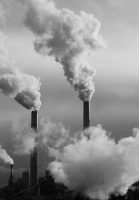Pacific Northwest National Laboratory scientists present carbon capture research

Three scientists from the Department of Energy’s (DOE) Pacific Northwest National Laboratory (PNNL) recently presented findings
from their research on carbon capture at the annual meeting of the American Chemical Society (ACS).
Phillip Koech, David Heldebrant, and Deepika Malhotra discussed their work with a class of molecules designed to capture carbon dioxide emitted from power plants. The team recently reduced the viscosity of the carbon-removing substances by over 90 percent,
which means using them would require less energy.
The materials, known as water-lean solvents, absorb gas from a plant’s waste stream, release it and then repeat the process, collecting it
for possible use in oil recovery or the manufacturing of plastics and other products.
PNNL scientists Vanda Glezakou and Roger Rousseau identified the molecular bond that was causing the high viscosity. The other researchers then altered a single hydrogen bond, which changed the viscosity of the material from that of honey to a consistency more like water.
The material used in the research releases the gas it collects at 60 degrees Celsius and regenerates at 100 degrees Celsius, improvements over current technologies because lower temperatures mean that less energy is required to perform reactions.
